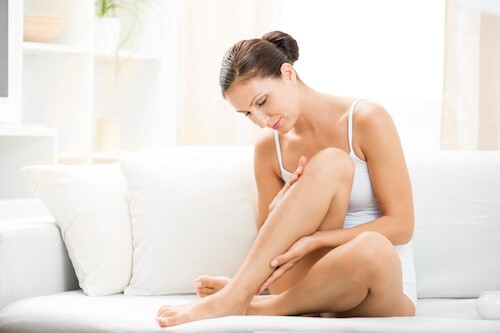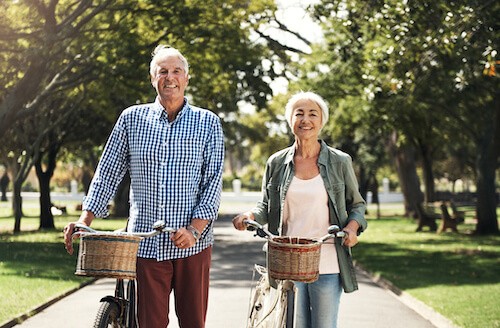Myths and misconceptions about varicose veins abound, from who gets varicose veins to the causes and treatments. These myths perpetuate inaccurate information that causes many people to postpone treatment that can put their health at risk unnecessarily. In this two-part series (see Part 2 here), we will dissect and dispel some of the main myths surrounding varicose veins.
MYTH #1: Varicose Veins are Only Treated for Cosmetic Reasons
The cosmetic benefits of varicose vein treatments can’t be understated. Modern vein treatments make your legs look great and help you feel good about yourself so you can lead an active life without feeling the need to hide your legs or avoid going out in public. While it’s true that in the early stages of the disease some varicose veins don’t cause pain or discomfort, as the condition progresses painful symptoms such as burning or itching; leg or ankle swelling; and leg heaviness, fatigue, pain, aching, or cramping can occur due to the effects of impaired circulation and tissue damage.
Unfortunately, it’s also true that many people are unaware that the problems with varicose veins go far deeper than purely cosmetic issues. Varicose veins are a sign of a condition called venous insufficiency, or venous reflux disease which worsens over time. Symptoms of venous insufficiency can vary from person to person. Some people experience burning or itching from tiny spider veins whereas, other people might have bulging varicose veins that don’t cause any noticeable physical symptoms until they reach an advanced stage. Additionally, in up to 20% of people with varicose veins, blood clots, or deep vein thrombosis (DVT) can be present for some time without causing symptoms[1].
Varicose vein treatments improve your health by reducing venous insufficiency, restoring circulation, and preventing symptoms from progressing, which can lead to disabling chronic pain. Not to mention, potentially keeping you out of the emergency room!

MYTH #2: Only Women Get Varicose Veins
It’s easy to be misled into thinking that only women get varicose veins. The grain of truth behind this myth is that women are more susceptible to developing varicose veins at younger ages than men due to the effects of female hormones and the stresses of pregnancy. Another reason that this myth perpetuates is that women are more likely to seek help for their varicose veins, possibly due to caring more about their “looks” than men. Additionally, the focus on varicose veins in women may have led to a lack of reporting on varicose veins in men in the past due to a prevalence of younger age groups being studied[2].
Varicose veins are nearly as common and widespread in men as they are in women. While percentage estimates vary, the highly regarded Edinburgh Vein Study placed the rate of incidence at 17.4% for women and 15.2% for men aged 18-64. The rates increase dramatically over the age of 65.

MYTH #3: Varicose Veins Are an Elderly Person’s Problem
This myth is partly true. If you look around, you will likely see more older people with varicose veins than younger people and your eyes will not be deceiving you. This is because the risk for developing varicose veins increases as we age. Another factor that may bolster this myth is the fact that venous insufficiency and varicose veins are progressive conditions that start off mild and gradually progress over time. It’s not uncommon to see someone with a few minor varicose veins and, because it’s so common in the early stages you might not even think anything of it.
However, varicose veins and venous insufficiency are by no means limited to the elderly. It’s been reported that initial symptoms of chronic venous disease occur at an average age of 31 years in women and 37 years in men[3]. Statistically, 14% of women develop chronic venous insufficiency before the age of 55[2].
MYTH #4: Nothing Can Be Done to Treat Varicose Veins
If you have inherited any or all of the 30 genes associated with varicose veins, you have up to 60% greater risk for getting varicose veins[4]. But while you can’t do anything to change your genetic predisposition there is simply no truth to the myth that you can’t do anything to treat varicose veins if you get them. In fact, there are various things that you can do to prevent or delay the development of varicose veins or manage existing varicose veins in the mild to moderate stages.
Self-care goes a long way when it comes to varicose vein prevention and management. Walking and eating a healthy diet can improve your circulation, lower blood pressure and blood sugar, and help you maintain a healthy weight, all of which can help to prevent and/or reduce the progression of varicose veins.
Also, elevating your legs and wearing compression stockings can reduce symptoms by preventing sluggish blood flow and swelling that can accompany varicose veins.
And, we’re pleased to say, if your varicose veins require medical treatment there are many excellent, low-risk, minimally invasive options for all stages of varicose veins.

MYTH #5: Surgery Is the Only Treatment Option for Varicose Veins
For many years complex vein stripping or ligation surgery was the only medical option for treating varicose veins. Though vein surgeries improved over time, many disadvantages persisted. These procedures were lengthy, required general anesthesia or spinal anesthesia, and required long healing times[5]. Additionally, there were high rates of complications including infection, bleeding, and scarring[5].
The next generation of technical advancements in varicose vein treatment following stripping surgery was laser surgery. This procedure was less painful; however, it usually required multiple visits and the high temperatures used in laser procedures can cause the temperature of the internal vein walls to reach upwards of 1100F to 1200F, which can cause complications such as burns, skin discoloration, nerve damage, and dead tissue in the area around the treated vein[6,7]. Also, laser vein treatment still required a lengthy healing time during which patients were unable to return to their normal activities. Post-procedure healing from laser surgery required rest, use of ice packs, and compression stockings, which are very uncomfortable, especially during the heat of summer.
Varicose vein treatments nowadays are much improved with a variety of minimally invasive treatment methods, but this information has been slow to spread to the general public and replace old, time-worn perceptions. The newer techniques, including VenaSeal™, are performed through one, or very few, tiny incisions, which minimizes surgical complications, such as infection and scarring, and practically eliminates healing time, allowing patients to resume normal activities immediately in most cases.
To learn more about your vein health and which vein treatment is right for you we invite you to schedule a free consultation at Empire Vein & Vascular Specialists. All of our physicians are board-certified vascular surgeons who specialize in helping people like you.
Empire Vein & Vascular Specialists is the top provider of VenaSeal™, the leading outpatient varicose vein treatment, in the USA. Schedule a free consultation today by calling 1-800-827-4267 (1-800-827-4267).
This two-part series is continued with Varicose Vein Myths Part 2. Click to read here.
References
- Prevalence of Isolated Asymptomatic Deep Vein Thrombosis in Varicose Vein Patients with Superficial Thrombophlebitis: A Single Center Experience in Japan. Ann Vasc Dis, 2016. 9(1): p. 2-7
https://pubmed.ncbi.nlm.nih.gov/27087866 - Prevalence of varicose veins and chronic venous insufficiency in men and women in the general population: Edinburgh Vein Study. J Epidemiol Community Health, 1999. 53(3): p. 149-53
https://pubmed.ncbi.nlm.nih.gov/10396491 - Heritability of chronic venous disease. Hum Genet, 2010. 127(6): p. 669-74
https://pubmed.ncbi.nlm.nih.gov/20354728 - Biomolecular mechanisms in varicose veins development. Ann Vasc Surg, 2015. 29(2): p. 377-84
https://pubmed.ncbi.nlm.nih.gov/25449990 - Varicose vein ligation and stripping. Aorn j, 2019. 109(4): p. P9-P11
https://pubmed.ncbi.nlm.nih.gov/30919421